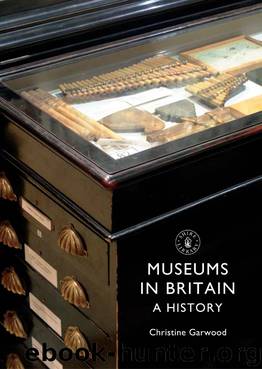Museums in Britain by Christine Garwood

Author:Christine Garwood
Language: eng
Format: epub
Tags: Museums in Britain: A History
ISBN: 9780747815266
Publisher: Osprey Publishing Ltd
Museums are still closely associated with old-fashioned glass cases and displays, seen here at the Royal Mint Museum and in the shark room at the Natural History Museum.
Meanwhile, the wider world of museums had become still more diverse with an array of new types of institution, their establishment driven by numerous factors, scientific, technological, economic, social and specialist – from the eccentric to the sublime. This includes a number of museums dedicated to the military and war: most famously, Imperial War Museums (IWM), a national museum organisation with five sites in England – warship HMS Belfast, historic airfield IWM Duxford, underground wartime command centre the Churchill War Rooms, Salford-based Imperial War Museum North and the original Imperial War Museum in London. The latter was established in 1917 to record the civil and military war effort and sacrifice of Britain and its empire during the First World War, although its remit now covers all conflicts involving British and Commonwealth forces since 1914. Integral to its role is the challenge of interpreting difficult subject matter (sometimes known as ‘hot interpretation’) from the Holocaust to recent politically contentious conflicts such as the Iraq War, a task backed by an extensive sound archive and object, art, film, video, photograph and archival collections. Originally housed at the Crystal Palace at Sydenham Hill, the museum opened to the public in 1920; from 1936 it found a permanent home in the buildings of the Bethlem Royal Hospital, the Southwark institution for treatment of the insane. It survived bombing during the Blitz to become the leading public museum organisation for conflict and war. Likewise focused on the interprelation of war are the National Army Museum, established in 1960, and the Royal Naval Museum at Portsmouth dockyards, as well as by numerous smaller museums and museum galleries dedicated to – and often funded by – individual regiments. The continuing prevalence of military heritage across Britain demonstrates the fundamental need to understand and memorialise the struggles and human cost inherent in war, and arguably more than any other venue reminds us of the larger place of museums, and of history, in the rationalisation and remembrance of certain aspects of the past.
Beyond war, the twentieth century has seen the opening of museums on almost every conceivable topic – from lawnmowers, toys and fans to pencils, Bakelite, baked beans and witchcraft, no subject seems too quirky or obscure. Some of the most intriguing are small independent organisations originally based on the objects owned by a specialist or enthusiast with a desire to spread knowledge about their subject, in some cases people whose personal collections have become so large that creating a public museum has seemed more practical than trying to store and display items in their individual homes. One such example is Robert Opie, founder of London’s Museum of Brands, Packaging and Advertising, whose collection of wrappings, tins, toiletries, posters and more began with a Munchies packet at Inverness station in 1963, which spurred his lifelong fascination with brands and what other people consider rubbish.
Download
This site does not store any files on its server. We only index and link to content provided by other sites. Please contact the content providers to delete copyright contents if any and email us, we'll remove relevant links or contents immediately.
Aircraft Design of WWII: A Sketchbook by Lockheed Aircraft Corporation(32171)
The Great Music City by Andrea Baker(31211)
Call Me by Your Name by André Aciman(20331)
The Secret History by Donna Tartt(18772)
The Art of Boudoir Photography: How to Create Stunning Photographs of Women by Christa Meola(18482)
Shoot Sexy by Ryan Armbrust(17617)
Plagued by Fire by Paul Hendrickson(17298)
Portrait Mastery in Black & White: Learn the Signature Style of a Legendary Photographer by Tim Kelly(16919)
Adobe Camera Raw For Digital Photographers Only by Rob Sheppard(16868)
Photographically Speaking: A Deeper Look at Creating Stronger Images (Eva Spring's Library) by David duChemin(16559)
Ready Player One by Cline Ernest(14455)
Pimp by Iceberg Slim(14236)
Bombshells: Glamour Girls of a Lifetime by Sullivan Steve(13933)
The Goal (Off-Campus #4) by Elle Kennedy(13382)
Art Nude Photography Explained: How to Photograph and Understand Great Art Nude Images by Simon Walden(12911)
Kathy Andrews Collection by Kathy Andrews(11689)
The Priory of the Orange Tree by Samantha Shannon(8805)
The remains of the day by Kazuo Ishiguro(8761)
Thirteen Reasons Why by Jay Asher(8746)
